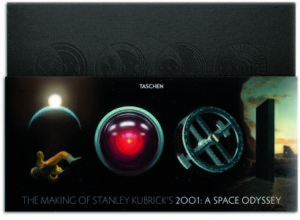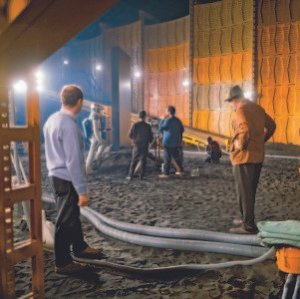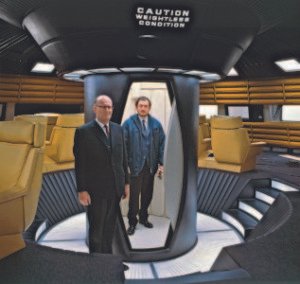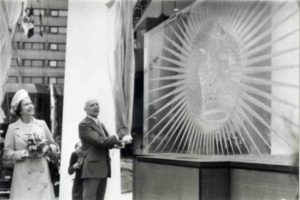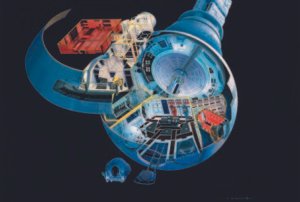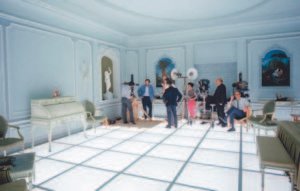The Making Of Stanley Kubrick’s 2001: A Space Odyssey by Piers Bizony (book review)
Several years back I heard about Taschen’s expensive limited edition book called ‘The Making Of Stanley Kubrick’s 2001: A Space Odyssey’ by Piers Bizony and am happy to say that its now been released as a more standard edition and half the price. Even more fortunate that Taschen have given me a copy to review.
The biggest surprise when opening the delivery box was how large and narrow the book was before discovering how heavy it is for its size. It took a few minutes waggling to carefully get it out of its thin card sleeve and then half an hour wandering through the pages, just for a taster of what to expect. I was expecting to see smaller photos (there are minute photos on the text pages incidentally) to fit the pages but, instead, most are full size and fold-out, sometimes right up to A3. None of this is helped by some photos spreading into the middle crease and had me wishing that Taschen do a third edition with a regular hardback format because this is really a nice book and you really do want to see every last detail.
Author Piers Bizony has written previous books about ‘2001’ but the number of photos, production paintings, crew photos and designs make this the most fulfilling book I’ve seen on the film to date. There’s even a small design illustration of the Discovery’s interior on page 144 that was used in, I think, ‘Flight International’ back in the early 70s and hadn’t seen since until now. Seeing it again now reminded me there’s a big empty gap behind the carousel that was never filled but I do wonder if that was where most of their supplies was kept.
Divided into nine parts, the first deals with Stanley Kubrick’s background leading up to that time, displaying his need for perfection and pushing people he worked with on the same edict. This wasn’t helped by the fact that he’s also a night owl and ringing people at these times when most people sleep. Mind you, we saw the benefit of that in ‘2001’, as explained in the book, he wanted every button detailed properly just in case it appeared in close-up. This kind of detailing has ensured an upgrade in quality in many SF films since.
Something I hadn’t known before but both Keir Dullea and Gary Lockwood are actually SF fans as well. There’s even a connection between the film’s hatch opening and ‘The Prisoner’ TV series door opening use the same sound effect. Oh, it’s also interesting seeing who was being considered for the various roles and why some were decided as unsuitable. Using unknowns has grown a lot since then and, I suspect, from the American pov, some of you are less inclined to see performers set in particular types.
Those of you who like scratch-building will find the plans for everything from spacecraft to interiors. Seeing how the interior of the Aries was made is quite an eye-opener. Most of the original models were made of hardwood so that they would survive any battering they might get.
It’s also interesting seeing who came up with what and how often both Clarke and Kubrick were groping around as to how to deal with certain story aspects. It’s hardly surprising that Clarke came up with the wormholes for the ultimate trip but it was actor Gary Lockwood who suggested that HAL lip-read Bowman and Poole. Some of the information of why HAL broke down ended up in ‘2010’.
Chapter three really gives all the production details and how much hard work is done to get perfection and burnt out a lot of the team. Even so, Kubrick encouraged experimentation at a time when the UK Borehamwood MGM studio was being allowed to run down.
There’s a lot of info given here. I mean, the AE35 unit itself on the computer screen was actually a white wire model as the way we would do it on a computer today couldn’t be done back in 1966. Although a lot of the computer technology looks a little primitive today, as indeed does any pre-80s film and TV series, the displays look more like we expect. Also, ‘2001’ was probably the first film to show Ipads in use on the Discovery.
Something I hadn’t known was that transparent crystal version of the Monolith as used in the novel was actually attempted but its green tint caused by light refraction made it a bad choice. For those considering making their own Monolith, will have to select hard wood, a lot of paint and keep it away from gathering dust. Although only mentioned in the book, I tracked down a picture of what happened to it and found the now engraved ‘Crystal Crown’ still on show in London.
The amount of photos from the film is jaw-dropping. Seeing the Discovery’s control deck which, through no gravity, is actually facing down, a bit weird for looking out the windows, I couldn’t help think of how this was used in the sequel ‘2010’. There’s also a cutaway of the Discovery which is intriguing and also points out where Bowman got his green helmet from. Seeing the construction of the various sets shows the scale of the design and especially that of the Discovery centrifuge. One thing I wish was covered was what the various screen displays actually represented. Things like ‘ATM’ for atmosphere and ‘COM’ for communication is easy to work out but the likes of ‘FLX’ and ‘VTM’ still baffle me.
Oddly, although the processes used for making the ‘ultimate trip’ are explained, there are very few stills from the film of them. In contrary, there is a lot more of ‘the dawn of man’ with how Dan Richter trained his team and how Kubrick had to decide what era they belonged to. Something I hadn’t known was a young comedian called Ronnie Corbett was used in one of the make-up attempts but looked too scary.
If you want a little poser, Bizony points out that there were eight murders in the film. Although he doesn’t list them until later in the text, it should exercise your brain as to what were the final two. Oddly, I got them all right.
Something that should be familiar with all ‘2001’ fans is how the older studio executives and their wives didn’t understand the private viewing but on general release, the younger generation did and raised it to classic status. Kubrick was also a notorious photo-taker of his own films or ensuring others did so and much more is shown here than in other books.
Bizony’s analysis of the film and how impersonal things had gotten into this reality and how HAL gained the humanity that the astronauts had lost is quite telling where mankind was going. Looking at it from this light, maybe the Monolith’s intervention with Bowman might have been the thing to shake up mankind. When you compare this to Clarke’s novel ‘Childhood’s End’, where Man also evolved into an advanced state and lost their personalities in the process, there is an odd connection
As you can tell from the length of this review, this is a fabulous book and although I’m not that keen on the shape, I suspect at some point I will have it upright in my bookcase and reaching it from my bed, just in case I turn into a starchild. It certainly won’t be gathering dust for long.
GF Willmetts
August 2015
(pub: Taschen. 562 page illustrated narrow large hardback. Price: £49.95 (UK). ISBN: 978-3-8365-5954-6)
check out website: www.taschen.com/

